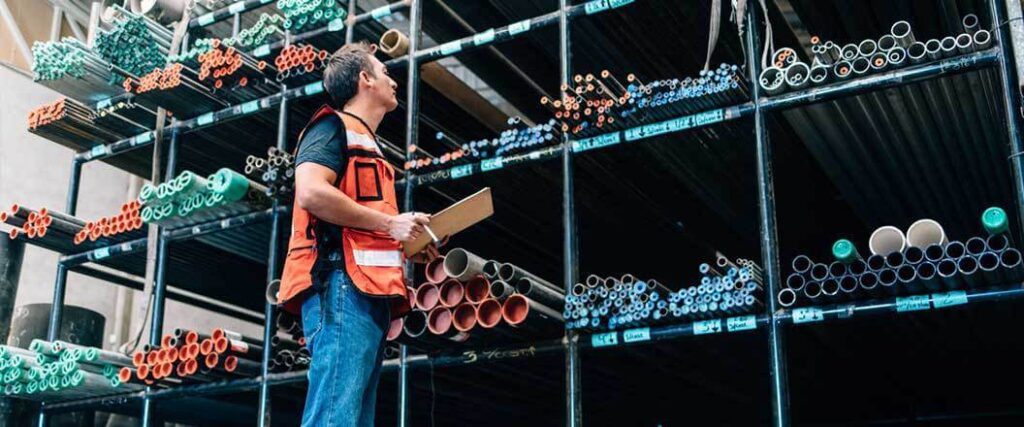Transporting pipes on trucks is one of the most commonly employed methods for moving pipes from one location to another. It offers a practical and efficient solution, ensuring that pipes reach their final destination in a timely manner. However, it’s important to consider related challenges such as loading, tieing down, and avoiding hazards that come with hauling large cargo. Safely and legally transporting pipes on trucks requires expertise and proper handling to ensure the integrity of the cargo and the safety of others on the road.
The American Trucking Associations (ATA) estimates that over 100 million tons of pipes are transported by truck each year in the United States. Trucks are the most common mode of transportation for pipes, as they offer a cost-effective and efficient way to move large quantities of material over long distances.
Let’s take a look at the materials used to make pipes, the most effective methods for pipe transport, and how Heavy Haul and Oversized can help you meet your pipe-hauling needs.
Pipes are commonly made from a variety of materials, including steel, concrete, and PVC. The material from which the pipe is constructed will often dictate its usage. We’be broken down the most common pipe materials and their applications.
| Material | Characteristics | Applications |
| Steel | Strong Durable Easy to customize and install | Hot water Crude oil Natural gas Foundations and framing Underground utilities |
| Concrete | Exceptional strength Long life Immune to most corrosion factors | Storm drains Culverts Sewage Cable management |
| PVC | Resistant to corrosion and chemicals Minimizes blockages Easy to install Leak-resistant fittings | Residential and business plumbing Water for drinking Exhaust and ventilation |
| Aluminum | Most corrosion resistant metal pipe Lightweight and durable More malleable than steel | Exhaust systems Compressed air Power transmission lines |
In addition to usage and materials, it’s important to consider the following factors when hauling pipes on a flatbed or any other kind of trailer:
Taking the weight of the load along with the size and shape of the pipe or pipes being hauled into account is key to choosing the right trailer and tie down materials.

There are a variety of trailer designs that can be used to transport pipes. The best design for a particular application will depend on the size, weight, and type of pipes being transported.
Some of the most common trailer designs for transporting pipes include:
The versatility of flatbed trailers means that they can be used for hauling concrete pipe, steel pipe, or almost any kind, safely and securely. Let’s examine the most common loading procedures for pipes on a flatbed trailer.

Get your heavy cargo moving on schedule! Click the button below to receive a no-obligation, personalized quote from our industry experts. Elevate your transport experience now!
Flatbed trucks are a common way to transport pipes of all sizes. However, loading something round onto something flat requires some careful considerations.
The following steps lay out how flatbed pipe loads should be stored on a trailer.
It’s also important to follow some general safety tips while loading your trailer, such as:
Following these tips will go a long way toward getting your haul from point A to point B without issues. It’s also a good idea to load the trailer on level ground. This will minimize the risk of load shifting while the trailer is in transit.
Knowing how to secure pipe on a flatbed is a crucial element of safe hauling. This is especially important for concrete and steel pipes, which are heavy and can cause significant damage if they shift in transit.
Some of the best practices for securing pipes on flatbed trucks include:
Now that you know how to strap down pipe on a flatbed, you can just worry about getting to your destination as quickly as possible, right? Not exactly. It’s equally important to observe precautions while pipe hauling.

Safety doesn’t stop once the pipes are securely loaded. There is still the drive of hundreds or even thousands of miles to consider. Following certain guidelines will go a long way toward making sure that your load of pipes arrives undamaged during the pipe transportation procedure.
Keep the following points in mind:
By following these tips, you can help to ensure safe transport of pipes.

Reach out to us at (866) 902-2713 or fill in the form and a live agent will be in touch shortly.
When unloading pipes, it is important to use the correct unloading techniques for the type of pipe being unloaded.
Here are some best practices for unloading pipes:
Some additional tips for unloading pipes safely include:
Practicing caution can be the difference between dropping off your payload without incident and causing a potentially damaging accident.
Proper pipe transport techniques and safety measures are important to ensure the safe and efficient delivery of pipes. At Heavy Haul and Oversized, we offer a variety of shipping services tailored to hauling large items such as pipes.
These include:
If you’ve been looking into pipe hauling companies, Heavy Haul and Oversized is the perfect choice to handle your pipe payload. Give us a call at 866-547-0967 or complete a quote request form to learn more about our services and to get a quote today!
Heavy Haul and Oversized
315 NE 14th Street #4122
Ocala, FL 34470
I'm looking to join a good truck driving team I am an owner operator